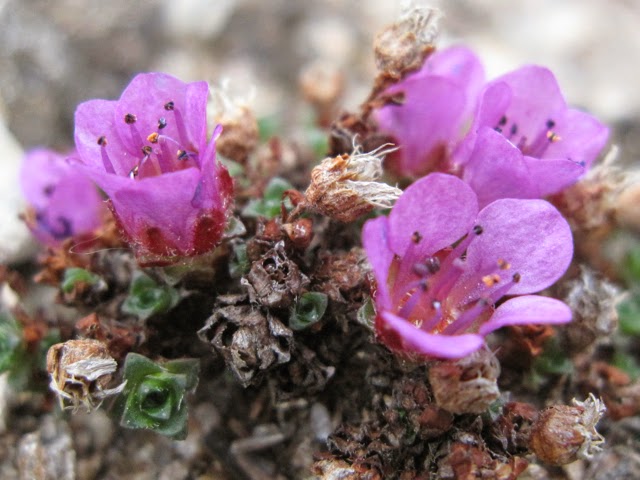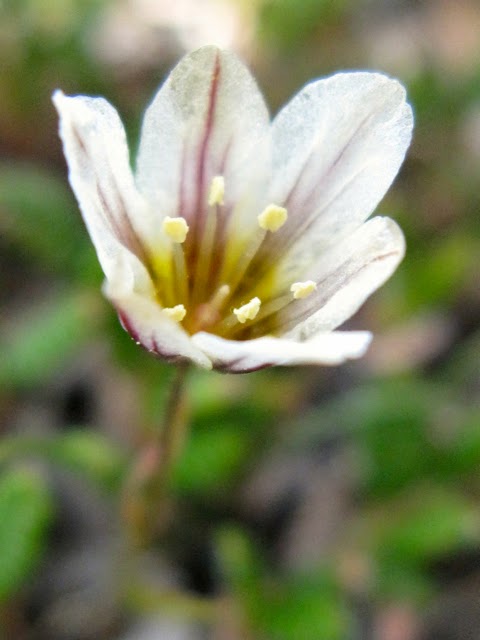Monday, June 9, 2014
June 8 - Moss Campion
The moss campion (Silene accaulis) is just starting to bloom along the rocky, alpine ridges. I found many of these cushion-like mossy mats, but few with flowers blooming. The leaves are short and flat. The light pink flowers have five petals with ten stamens and are very aromatic.
June 8 - Purple Mountain Saxifrage
The purple mountain saxifrage (Saxifraga oppositifolia), or French knot plant is blooming in the alpine rock gardens. This plant forms very unique, small, dark green leaf rosettes that look like French knots. The cup-shaped, five-petaled flowers are magenta to purple in color.
June 8 - Lapland Diapensia
Lapland diapensia (Diapensia lapponicum ssp. obovata) is blooming on the rocky ridges up in the alpine. This plant has hard, oval evergreen leaves that form small rosettes in a tight mat. The white bell-shaped flowers have five petals with five stamens.
June 8 - Arctic Sandwort
The arctic sandwort (Minuartia macrocrpa) is starting to bloom amongst the rocks in the alpine. Flowers are cup shaped with five white petals on short stems. Leaves are small and narrow on this mat-forming plant.
June 8 - Lapland Rosebay
Lapland rosebay (Rhododendron lapponicum) is blooming along the rocky ridges of the alpine. These magenta colored flowers have long stigma. The small, oval, evergreen leaves are whorled along the stem and have a rusty color on the underside.
June 8 - Shrubby Cinquefoil
The shrubby cinquefoil (Potentilla fruiticosa) is just starting to bloom. Only found a couple shrubs in bloom on my hike and they were at lower elevations, growing on rocky slopes. This plant is also called the tundra rose. These shrubs can get very bushy and beautiful with all the flowers blooming. The flower petals are about an inch long and very rounded. Leaflets have 5 narrow leaves.
June 8 - Arctic Willow
Sunday, June 8, 2014
June 8 - Rosewort
June 8 - Bell Heather
The moss heather (Cassiope tetragona) is just starting to bloom in the alpine meadow slopes. Most of what I found was still very dried out and brown, but some of it was greening up with buds and flowers. This plant is really a dwarf evergreen shrub with leaves that look like stacked columns. It has a nice aroma.
June 8 - One-flowered Cinquefoil
The one-flowered cinquefoils (Potentilla uniflora) are now blooming in the high alpine rock gardens. These bright yellow flowers have an orange spot at the base of each petal and are about an inch in diameter. The petals are very soft and velvety.
June 8 - Sticky Oxytrope
Sticky oxytrope (Oxytropis viscida) is abundant right now in the sub-alpine meadows. The flowers are lavender colored. Both the leaves and the calyx feel slightly sticky.
June 8 - Smooth Draba
I found some smooth draba (Draba hirta) blooming in the higher alpine meadows. This very tiny plant is the smallest flower I've ever tried to photograph -- very tough in the wind with just a Cannon PowerShot Elph.
June 8 - Narcissus-flowered anemone
The narcissus-flowered anemone (Anemone narcissiflora) is very abundant right now from the high alpine meadows to the lower sub-alpine woodlands. This plant is about a foot tall with flowers about 2 inches in diameter; much larger than most other alpine flowers right now. The white flowers have a bluish color on the underside. They have a unique modified leaf just below the flower that completely surrounds the stem.
June 8 - Mountain Avens
June 8 - Purple Cress
I found two different colors of purple cress (Cardamine purpurea) in the high alpine meadows. This tiny flower is part of the mustard family. It is only a couple inches tall with a cluster of tiny, four-petaled flowers at the top. The leaves are surprisingly tasty and really good added to a salad.
June 8 - Rock Jasmine
Rock Jasmine (Androsace chamaejasme) are blooming like crazy in the alpine meadows. I've never seen so many of them in one hike. They were everywhere! This tiny little white flower is only a couple inches tall and has a distinctive yellow center. The flowers are tiny -- about 1/3 of an inch, and are clustered at the top of a hairy stem. The leaves are very small and found in tight rosettes at the base.
June 8 - Wooly Lousewort
The alpine meadows are full of wooly lousewort (Pedicularis Kanei ssp. Kanei) right now. The flowers are a vibrant pink surrounding a thick wooly stalk. The leaves are fernlike and purplish when the plant is young.
June 8 - Arctic Lupine
The arctic lupine (Lupinus arcticus) is just starting to bloom on the lower alpine slopes. I found lots of leaves of this plant but very few flowers blooming; it's still a little early for them.
June 8 - Alp Lily
The alp lily (Lloydia serotina) was blooming up high in the alpine meadows. This tiny flower is only 3 or 4 inches tall. It has a creamy-white color with distinctive purple veins. Leaves are very narrow and look like grass.
June 8 - Purple Oxytrope
The purple oxytrope (Oxytropis nigrescens) was the dominant flower of the day on my hike up the east side of Mount Healy. I started to see it in the sub-alpine and it was blooming everywhere in the high alpine meadows. There are generally two tiny, purple flowers per stem. The calyx is covered with fuzzy hairs.
June 8 - Parry's Wallflower
I found a northern facing meadow in sub-alpine containing parry's wallflower (Parrya nudicaulis ssp. interior). This delicate, lavender flower was about 7 inches tall (18 cm) growing on a tundra covered slope. It has a subtle aroma. The dark green, edible leaves, about 4 inches long (10 cm) grow from the base and have wavy edges.
June 8 - Splendid Forget-me-not
The splendid forget-me-not (Eritrichium splendens) is one of my favorite wildflowers. This tiny fluorescent blue flower grows in matts along the rocks in the sub-alpine. Stems are short and close to the narrow leaves.
June 8 - Prickly Saxifrage
The prickly saxifrage (Saxifraga tricuspidata) was blooming on the lower sub-alpine mountain slopes amongst the rocky scree. The tiny flowers are so beautiful with their yellow, orange and red spots. This evergreen plant has leaves that grow in rosettes and are tinged with red in the spring. They have three sharply pointed prongs at the end and when they dry out, they are very prickly. Flower stems are about 6 inches long (15 cm) topped with a cluster of small five-petal flowers.
Friday, June 6, 2014
June 6 - Bog Cranberry
The bog cranberry (Vaccinium vitas-idaea) is also known as low-bush cranberry, lingonberry and mountain cranberry. I'm sad to see that it is not very abundant this spring in my usual picking areas. This is my favorite berry to pick in the fall after the first frost. I collect gallons to use for making cranberry juice all year round. This tiny flower grows in bogs, tundra, taiga forests and alpine slopes. The flowers are pink to white bell shapes. The evergreen leaves are shiny, hard ovals with their edges rolled under.
June 6 - Cloudberry
Cloudberry (Rubus chamaemorus) flowers are very abundant right now in the tundra and boggy areas. These white flowers have 4 or 5 petals and are about 3/4 inch long. The leaves are coarsely veined, toothed with 5 lobes. When the berry forms, it looks like a clump of orange salmon eggs, so the plant is also called salmonberry by the Alaska Natives. This is a very different salmonberry than the sweeter variety found in southern Alaska. The berries are edible and can be eaten raw or cooked. I personally don't like the raw berries because they are not very sweet, but the berries do make excellent jelly.
Labels:
cloudberry
Location:
Stampede Road, Healy, AK 99743, USA
June 6 - Labrador Tea
The labrador tea (Ledum palustre ssp. groenlandicum) is just starting to bloom in the tundra and taiga forests. It should be very abundant by middle June. These small flowers grow in clusters at the end of the shrub's branch. The leaves have a nice aroma and have historically been used in folk medicine for colds and other ailments using a weak concentration; 1 tsp of dried leaves for 1 cup of boiling water. Stronger concentrations may cause horrific headaches. Leaves are also used to keep moths away from clothes.
Labels:
labrador tea
Location:
Stampede Road, Healy, AK 99743, USA
June 6 - Arnica
Labels:
frigid arnica
Location:
Stampede Road, Healy, AK 99743, USA
May 14 - Snow Draba
The snow draba (Draba nivalis), is a very tiny white flower that is hard to photograph. It is only a couple inches tall with flowers branching from the top of its stem. I found it growing on a dry, rocky slope with full sun. It is part of the mustard family.
May 14 - Windflower
The windflower, or northern anemone (Anemone parviflora), is abundant by mid-may. It is found in meadows and along streams. The white flowers sway in the wind, thus the name. The toothed leaves are rounded with three sections. Flowers have 5 rounded sepals.
May 8 - Frigid Coltsfoot
The frigid coltsfoot (Petasites frigidus) was the second flower I found this spring. It grows in wet meadows and woodlands and has triangular shaped leaves. The flowers are a pinkish-white color found in clusters.
May 1 - Pasque Flower
The first flower of spring in Denali is the pasque flower, or spring crocus (Pulsatilla patens). It can be found on well-drained slopes with sandy soil. I was surprised to find it so early this year, but with unusually warm temperatures and an early snow melt, it was abundant on the slopes above Triple Lakes on May Day. I love finding this first flower of spring. While beautiful, it is also poisonous if eaten.
Subscribe to:
Posts (Atom)











































